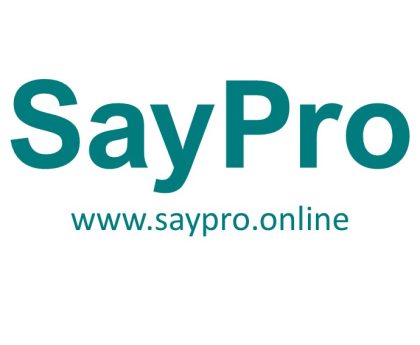SayPro Collaboration & Strategy Refinement HR Process Optimization: Continuously analyze and improve SayPro’s recruitment, training, and performance management processes to ensure that they are efficient, effective, and tailored to the needs of the business from SayPro Monthly January SCMR-17 SayPro Monthly HR Services: Recruitment, training, performance management by SayPro Online Marketplace Office under SayPro Marketing Royalty SCMR
1. Overview of HR Process Optimization
HR process optimization is a continuous effort to evaluate and refine the recruitment, training, and performance management functions at SayPro to ensure they are operating efficiently and aligning with the overall business goals. By focusing on streamlining HR processes, SayPro can reduce inefficiencies, improve employee experience, and ensure that HR practices are agile enough to respond to the changing needs of the business.
Optimizing these processes is key to improving talent acquisition, employee development, and overall organizational performance, while ensuring that HR remains adaptable to business dynamics.
2. Objectives of HR Process Optimization
A. Improve Efficiency
- Optimization focuses on eliminating redundant steps, automating repetitive tasks, and leveraging technology to speed up HR processes. This makes HR more efficient, which in turn helps the organization make better use of its resources.
B. Increase Effectiveness
- Optimized processes should lead to better outcomes. For example, streamlining the recruitment process will ensure that SayPro attracts and hires the best talent, while an effective performance management system leads to improved employee performance.
C. Tailor HR Practices to Business Needs
- Optimized HR processes should always be responsive to SayPro’s specific needs. This means continuously adapting HR practices to match the organization’s growth, changes in strategy, and shifts in the marketplace.
D. Enhance Employee Experience
- Process optimization should focus not only on operational efficiency but also on improving the employee experience. A streamlined and transparent HR process benefits employees by creating a smoother, faster, and more satisfying experience throughout their lifecycle at SayPro.
3. Key Areas for HR Process Optimization
A. Recruitment Optimization
- Streamline Job Postings & Applications
- Simplify job postings by clearly defining roles and responsibilities while ensuring that they align with SayPro’s strategic goals. This will attract the right candidates who match both the technical and cultural fit for the roles.
- Use SayPro’s recruitment platform to automate job postings to relevant job boards, social media, and professional networks. Integrating AI-based tools can further assist in shortlisting candidates.
- Create standard templates for job descriptions to ensure consistency across departments.
- Automate applicant tracking using HR software to streamline candidate selection.
- Reduce unnecessary steps in the application process, such as overly lengthy forms or redundant assessments, to improve candidate experience and reduce drop-off rates.
- Candidate Sourcing and Screening
- Identify and leverage additional channels for sourcing talent, including industry-specific job boards, social media platforms, and employee referrals, which can yield better-qualified candidates.
- Implement automated pre-screening assessments and resume scanning to reduce manual efforts and expedite the screening process.
- Integrate AI-driven tools for resume parsing and keyword matching.
- Use video interviews or automated screening calls to speed up initial candidate engagement.
- Train hiring managers on quick and effective evaluation techniques.
B. Training Optimization
- Personalized Training Paths
- Conduct regular training needs assessments to understand skill gaps across departments. Tailor training programs to address both individual and team-specific challenges.
- Focus on delivering modular training sessions that employees can complete at their own pace. This makes learning flexible, more accessible, and employee-driven.
- Develop an integrated learning platform that allows employees to easily track their progress and access relevant content.
- Create personalized learning plans for employees based on their current performance and career goals.
- Automate training reminders and certifications to keep employees engaged and motivated.
- Training Delivery and Format Innovation
- Enhance the quality of training by using blended learning formats, such as a mix of online webinars, self-paced modules, and in-person workshops. This variety makes training more accessible and keeps employees engaged.
- Use data analytics to track which training formats are most successful and preferred by employees.
- Create on-demand learning materials and resources that employees can access at any time, enhancing flexibility.
- Implement gamification strategies or incentives to make training more engaging.
C. Performance Management Optimization
- KPI Alignment and Goal Setting
- Ensure that performance metrics are linked directly to the strategic goals of each department and the company as a whole. By refining the process of defining KPIs, SayPro can ensure that they are aligned with both short-term and long-term business goals.
- Implement automated goal-setting tools that help employees and managers align their objectives more effectively.
- Use real-time performance tracking tools that provide employees and managers with up-to-date data on progress.
- Set up quarterly reviews to adjust goals and KPIs as needed to reflect changes in business priorities.
- Continuous Feedback & Real-Time Appraisals
- Rather than waiting for annual performance reviews, HR should encourage continuous feedback and regular check-ins between managers and employees.
- Implement a continuous feedback loop where employees receive immediate and actionable feedback from their peers and managers.
- Use AI-powered tools to provide real-time feedback based on performance data.
- Introduce instant recognition programs, such as peer-to-peer recognition or automated praise, to foster positive employee behavior.
- Succession Planning & Career Development
- A part of performance management is to ensure that high-performing employees are given the opportunity for growth within SayPro.
- Create a transparent career development plan that employees can follow and track.
- Automate succession planning by identifying and tracking top performers within the company who can step into higher roles when vacancies arise.
4. Tools & Technology for Process Optimization
A. HR Technology Platform
- Leveraging a comprehensive HR technology platform, such as an HRIS (Human Resource Information System) or an integrated talent management platform, can help optimize recruitment, training, and performance management processes.Key Features:
- Automation of administrative tasks: Posting jobs, tracking applicants, scheduling interviews, and generating reports.
- Employee self-service portals: Enabling employees to update their information, enroll in training, and track their performance.
- Real-time analytics: Providing insight into hiring, training, and performance trends.
B. Data Analytics for HR
- Use data analytics to continuously monitor the effectiveness of HR programs. By analyzing key HR metrics, such as recruitment efficiency, training effectiveness, and employee performance, SayPro can make data-driven decisions to optimize HR processes.Key Metrics:
- Time-to-hire
- Training completion rates
- Employee engagement scores
- Performance trends
- Employee retention rates
C. Feedback Tools
- Use digital surveys, feedback tools, and performance management platforms that allow both employees and managers to offer real-time feedback.
5. Expected Outcomes of HR Process Optimization
A. Enhanced Recruitment Efficiency
- By streamlining recruitment and leveraging automation, SayPro can hire top talent faster and with fewer resources, reducing time-to-hire and improving the quality of hires.
B. Increased Employee Engagement
- Optimized training and development processes lead to more effective employee learning, boosting engagement and overall job satisfaction.
C. Improved Performance & Productivity
- Optimizing performance management processes, including continuous feedback and aligned KPIs, directly impacts employee performance and productivity.
D. Greater Agility & Flexibility
- With optimized HR processes, SayPro can be more adaptable to business changes, market trends, and shifting organizational needs.
E. Data-Driven Decision Making
- HR process optimization allows SayPro to continuously collect data on recruitment, training, and performance, providing leaders with actionable insights to refine HR strategies.
6. Conclusion
HR process optimization at SayPro is an ongoing initiative that involves continuous improvement and refinement of key HR functions — recruitment, training, and performance management. By leveraging technology, streamlining workflows, and aligning HR strategies with business needs, SayPro can create a more efficient and effective HR function that delivers value across the organization. This optimization not only supports the growth of employees but also contributes to the overall success of SayPro by attracting and retaining top talent, enhancing employee performance, and ensuring business goals are achieved.



